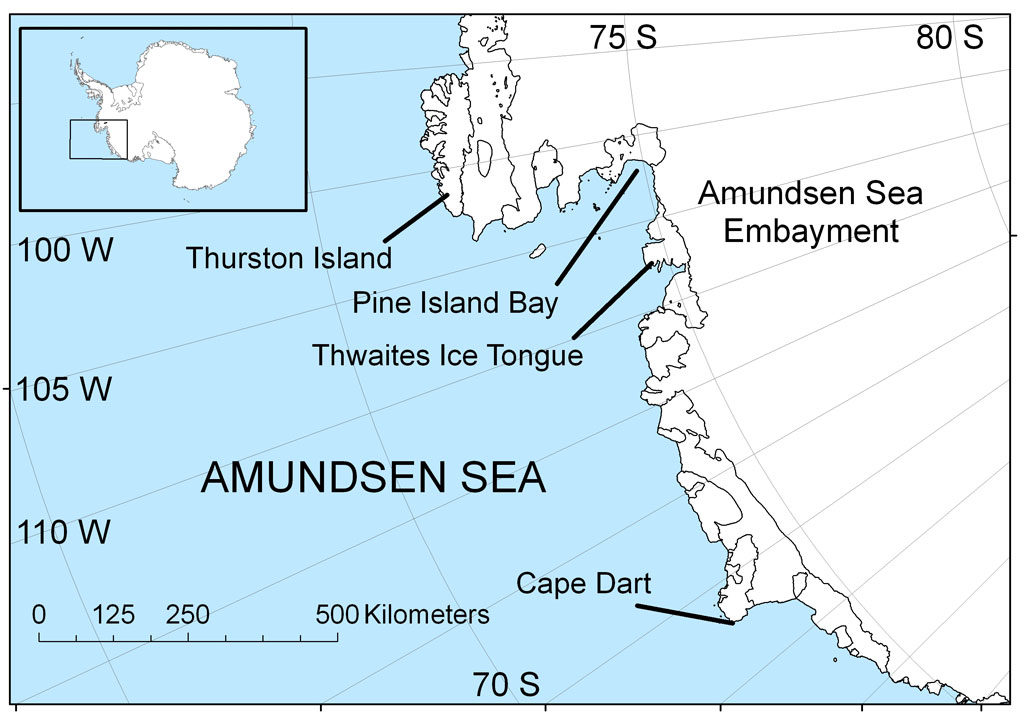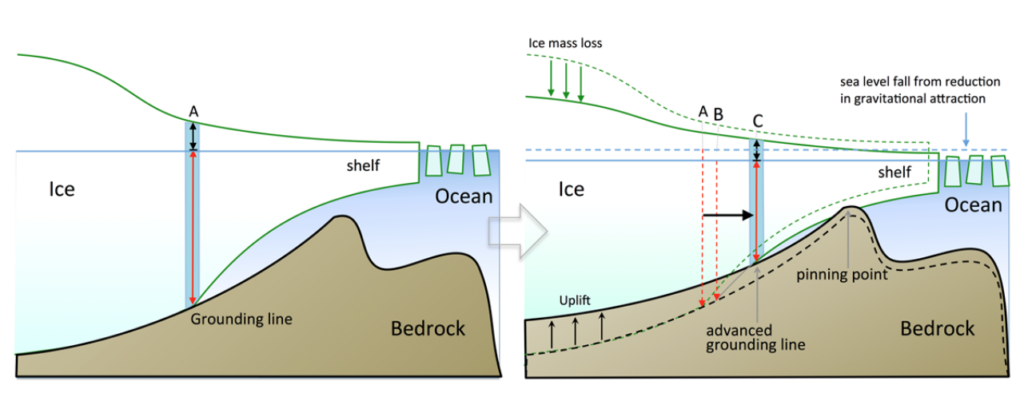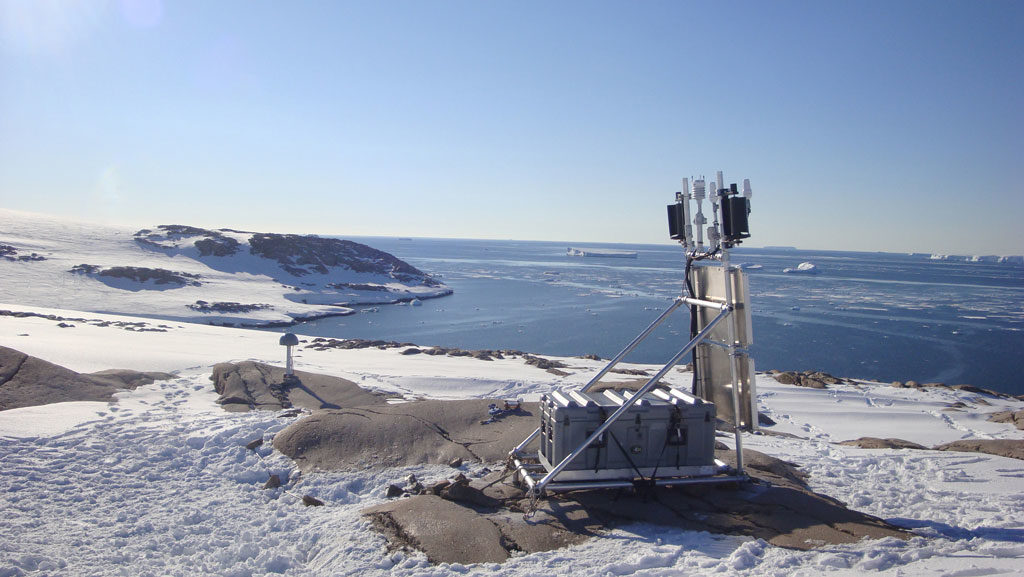Land uplift ‘could prevent’ collapse of West Antarctic ice sheet
Posted on 13 July 2018 by Guest Author
This is a re-post from Carbon Brief by Daisy Dunne
The rapid rise of bedrock beneath one of the fastest melting regions of the West Antarctic ice sheet could help prevent it collapsing, new research suggests.
The natural uplift of the ground in response to melting of ice could help stabilise the ice sheet by “literally pin[ning] the ice to the rock”, the lead author tells Carbon Brief.
However, the rising ground may also have “hidden” the true amount of ice loss from the area by around 10%, the results show.
In addition, if little is done to tackle future climate change and the rate of Antarctic ice melt continues to rise, the uplift of the land “will be useless” to stop the ice sheet from eventual collapse, the author adds.
Melting ice
Recent research suggests the rate of sea level rise from Antarctic ice melt may have tripled in the past five years – with melt from the West Antarctic ice sheet playing the largest role in the surge.
The Amundsen Sea Embayment (ASE) in West Antarctica (pictured below) is an area of ice roughly the size of Texas that drains into the Amundsen Sea, containing both the Pine Island and Thwaites glaciers.

The location of the Amundsen Sea Embayment in Antarctica. Source: Polargeo/Wikipedia
The ASE alone currently contributes a quarter of all of the world’s ice melt. In one year, the region loses enough mass to cover Denmark with almost three metres of ice (43,000 sq km).
Scientists have previously raised concerns that the West Antarctic ice sheet is particularly vulnerable to “collapse” – meaning that it could eventually lose all of its ice, potentially causing sea levels to rise by several metres.
This is largely because the region is made up of “marine-based” glaciers, which sit on land below sea level. Where the face of a glacier meets the ocean, warm water can melt it from underneath, gradually forcing back the “grounding line” – where the underside of the glacier rests on the seabed.
However, the new research, published in Science, suggests that the rapid rebound of the ground beneath the ASE’s melting glaciers could help stabilise the ice sheet. In the long run, this could prevent the West Antarctic ice sheet from collapsing.
This adjustment of the land once the weight of the ice has been lifted is known as “glacial isostatic adjustment”. It is usually thought to be a slow process, but the new data suggests the ground uplift beneath the ASE area is occurring at an unprecedented rate of 41mm per year, says lead author Dr Valentina Barletta, a postdoctoral researcher at the Technical University of Denmark. She tells Carbon Brief:
“We find a very different Earth structure under the ASE than we expected. After ice melt, the Earth normally takes thousands of years to rise up. In the ASE, we find that this uplift or rebound is so fast that is occurring in decades. Such fast rebound could stabilise the ice sheet.”
If current rates of ice melt continue over the next century, parts of the land beneath the ice sheet in the ASE region could rise by up to eight metres, the research finds.
Memory foam
To study the Earth’s movements, Barletta’s team collected data from six GPS stations across the ice sheet. The GPS data revealed that the land was rising at a rapid rate, Barletta says, but, to understand why, the researchers needed to use modelling:
“It’s a bit like detective work. We simulate all possible scenarios that can explain the few clues – the uplift recorded by the GPS. We ran 10,000 simulations to test all of the plausible scenarios and found that a mantle that is particularly soft can indeed reproduce the uplift we measure very well.”
The mantle is the part of the earth that lies between the core and the crust. How fluid, or “viscous”, the mantle is differs across the planet and plays a role in how quickly the land responds to changes in pressure, such as the melting of ice. Barletta says:
“When the ice melts and gets thinner, the Earth readjusts, and rises immediately by a few millimetres. But the Earth also acts a bit like a very hard memory-foam mattress and it slowly keeps readjusting for several thousand years after the melting.”
The findings show that the mantle beneath the ASE is “soft” – meaning that the bedrock reacts more quickly when the weight of ice is removed, she says:
“However, we don’t really know why the mantle is so soft. This is basically a mystery yet to be solved.”
Pinning points
The changes associated with the rapid uplift of the ground could help to stabilise the ASE in three main ways, Barletta says, which are shown on the diagram below, which depicts a glacier before (left) and after (right) the loss of ice and the resulting land uplift.
On the right hand of the diagram, the dashed lines represent the initial positions of the land, ice and sea level. On both sides, A indicates the initial position of the grounding line.

Diagram showing how ice melt and bedrock uplift could prevent ice sheet collapse. On both sides, A indicates the initial position of the grounding line. On the right, dashed lines represent the initial positions of the land, ice and sea level; B indicates the position of the grounding line when the reduction in gravitational attraction between ice sheet and ocean is considered and C shows the location of the grounding line when both land uplift and the reduction in gravitational attraction between ice sheet and ocean are considered. Source: Barletta et al. (2018)
First, the loss of ice reduces the local gravity and the gravitational pull on the water, resulting in a lower sea level at the adjacent Antarctic coast, Barletta explains:
“The reduction of the ocean depth in turn reduces the buoyancy of the whole ice sheet. So, to put it very simply, the ice sheet is more likely to stay grounded instead of floating away [from the seabed].”
On the chart, B indicates the position of the grounding line when the reduction in gravitational attraction between ice sheet and ocean is factored in.
Second, the uplift could cause the slope of the land beneath the ice sheet to become less steep (shown on diagram), which could, in turn, mean the ice “will slide back less”, says Barletta, slowing the outflow of ice.
Third, the uplift of the ground could lead to the rising up of ‘pinning points’ (shown on diagram) – elevated land features that “pin” the ice sheet to the bedrock, preventing the retreat of the grounded ice.
On the diagram, C shows the location of the grounding line when the three mechanisms are considered. In total, these processes could drive the grounding line forwards towards the sea, leading to less of the underside of the ice being exposed to the warm ocean, the study says.
However, the rising of the ground may have caused scientists to underestimate ice loss in the region by 10%, research finds.
To measure ice loss, researchers often use satellites – which take overhead measurements of weight change as a result of ice loss. However, the rising of land may have masked the true rate of ice mass loss, Barletta explains:
“The Earth rising partially hides the gravity signal coming from ice loss. So it’s a matter of interpretation, rather than ice loss change.”
Warming matters
As part of the research, the team used modelling to project how effective the uplift of the land would be in the protecting the ice sheet from future climate change.
The findings suggest that “in only the case of future mild (to moderate) climate change, our finding is a good news for the West Antarctic Ice Sheet”, Barletta says. However, “in the case of extreme climate change, any help to the ice sheet [in preventing eventual collapse] will be useless”, she adds:
“I hope the message is clear. In terms of reducing our impact on climate change, what we do might make a big difference.”
The findings also raise concerns that, while land uplift may protect ice sheets from collapse, a decrease in land elevation elsewhere could have the opposite effect, says study author Prof Terry Wilson, emeritus professor of Earth sciences at Ohio State University. She says:
“The physical geography of Antarctica is very complex. We found some potentially positive feedbacks in this area, but other areas could be different and have negative feedbacks instead.”
The findings suggest that “ice loss in this region has previously been underestimated,” says Dr Grace Nield, a postdoctoral researcher in Earth and polar sciences at the University of Durham, who was not involved in the research. She tells Carbon Brief:
“The rate of uplift reported in this paper is much faster than we were expecting and so the stabilising effect of rebound may play a larger role in controlling ice sheet change than we previously thought.”
While land uplift may protect the ice sheet from total collapse, it may not be able stop the collapse of vertical ice cliffs where the face of a glacier meets the ocean, which also contributes to sea level rise, says Dr Ed Gasson, a polar scientist from the University of Bristol, who was also not involved in the research. He tells Carbon Brief:
“Another style of collapse – the structural failure of ice cliffs – may not be prevented by isostatic rebound on these timescales, due to the depth of these basins.”
Ice cliffs collapse when ocean warming from beneath causes ice near the bottom of the cliff to melt, leading to the structure becoming too top-heavy.
Barletta, V. R. et al. (2018) Observed rapid bedrock uplift in Amundsen Sea Embayment promotes ice-sheet stability, Science, doi/10.1126/science.aao1447































 Arguments
Arguments































Comments